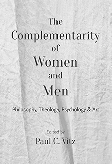The Complementarity Of Women And Men: Philosophy, Theology, Psychology, And Art -- By: David Talcott
Journal: Eikon
Volume: EIKON 04:1 (Spring 2022)
Article: The Complementarity Of Women And Men: Philosophy, Theology, Psychology, And Art
Author: David Talcott
Eikon 4.1 (Spring 2022) p. 156
The Complementarity Of Women And Men: Philosophy, Theology, Psychology, And Art
REVIEWED BY
David Talcott is Associate Professor of Philosophy at The King’s College (NYC). He is an elder at Covenant Presbyterian Church (PCA) in Short Hills, NJ, and has a forthcoming book Plato with P&R Publishing.

Paul C. Vitz, ed. The Complementarity of Women and Men: Philosophy, Theology, Psychology & Art. Washington, D.C.: The Catholic University of America Press, 2021.
In his encyclical Familiaris Consortio, Pope John Paul II stated that there was a “natural complementarity that exists between man and woman.”1 That idea was further developed in his sermons which were published as the Theology of the Body. This new collection of essays, edited by Paul Vitz, now comprises the most succinct, up to date, and intellectually robust defense of this idea of Roman Catholic “complementarity.” It is a view that is initially attractive to complementarians since it begins with this arresting insight: men and women are fundamentally equal, but they are not the same. Vitz writes, “The purpose of this book is to carry out what we see as the urgent task of exploring and elaborating the complementarity of the sexes from both a psychological and
Eikon 4.1 (Spring 2022) p. 157
a theological point of view” (1). The collection seeks to accomplish this through a range of disciplines, including philosophy, theology, psychology, and art, all from a Roman Catholic perspective. These articles show the way that conservative Roman Catholics can be partners with Evangelicals on social issues, and even some theological issues, but that they have not determined how to fit the biblical idea of headship into their theology of the sexes. As a result, the Catholic complementarity view stands in need of further development.
Complementarians will find much to appreciate about the Catholic exploration of these ideas. This collection is uniformly interesting and insightful. The first article is written by UT-Austin philosopher J. Budzisewski, and is a reprint of Chapter 3 of his book The Meaning of Sex.2 It remains a masterful-yet-accessible article, offering a wide-ranging account of manhood and womanhood in terms of potentialities. A man is a human being with the potential for fatherhood (physical and spiritual) and a woman is a human being with the potential for motherhood (physical and spiritual). These paternal and maternal capacities integrate the distinctive attributes of each...
Click here to subscribe
